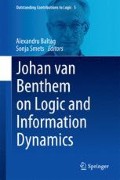Abstract
The concept of agency is important in philosophy, cognitive science, and artificial intelligence. Our aim in this chapter is to highlight some of the issues that arise when considering the concept of agency across these disciplines. We discuss two different views of agency: agents as actors (the originators of purposeful deliberate action); and agents as intentional systems (systems to which we attribute mental states such as beliefs and desires). We focus in particular on the view of agents as intentional systems, and discuss Baron-Cohen’s model of the human intentional system. We conclude by discussing what these different views tell us with respect to the goal of constructing artificial autonomous agents.
With apologies to Will Hutton.
Access this chapter
Tax calculation will be finalised at checkout
Purchases are for personal use only
References
Allen JF, Hendler J, Tate A (eds) (1990) Readings in planning. Morgan Kaufmann, San Mateo
Baron-Cohen S (1995) Mindblindness: an essay on autism and theory of mind. The MIT Press, Cambridge
Bayne T (2011) Libet and the case for free will scepticism. In: Swinburne R (ed) Free will and modern science. British Academy, Oxford, pp 25–46
Birnbaum L (1992) Rigor mortis. In: Kirsh D (ed) Foundations of artificial intelligence. The MIT Press, Cambridge, pp 57–78
Bordini R, Hübner JF, Wooldridge M (2007) Programming multi-agent systems in AgentSpeak using Jason. Wiley, Chichester
Bratman ME (1987) Intention, plans, and practical reason. Harvard University Press, Cambridge
Bratman ME (1990) What is intention? In: Cohen PR, Morgan JL, Pollack ME (eds) Intentions in communication. The MIT Press, Cambridge, pp 15–32
Brooks RA (1999) Cambrian intelligence. The MIT Press, Cambridge
Cohen PR, Levesque HJ (1990) Intention is choice with commitment. Artif Intell 42:213–261
Dennett DC (1983) Intentional systems in cognitive ethology. Behav Brain Sci 6:343–390
Dennett DC (1987) The intentional stance. The MIT Press, Cambridge
Dennett DC (1996) Kinds of minds. Phoenix, London
Dunbar RIM (1992) Neocortex size as a constraint on group size in primates. J Hum Evol 22:469–493
Dunbar RIM (2011) How many friends does one person need?: Dunbar’s number and other evolutionary quirks. Faber and Faber, London
Fagin R, Halpern JY, Moses Y, Vardi MY (1995) Reasoning about knowledge. The MIT Press, Cambridge
Genesereth MR, Nilsson N (1987) Logical foundations of artificial intelligence. Morgan Kaufmann, San Mateo
Georgeff MP, Lansky AL (1987) Reactive reasoning and planning. In: Proceedings of the sixth national conference on artificial intelligence (AAAI-87), Seattle, pp 677–682
Ghallab M, Nau D, Traverso P (2004) Automated planning: theory and practice. Morgan Kaufmann, San Mateo
Goldman AI (1995) Action. In: Guttenplan S (ed) A companion to the philosophy of mind. Blackwell, Oxford, pp 117–121
Guttenplan S (ed) (1995) A companion to the philosophy of mind. Blackwell, Oxford
Hintikka J (1962) Knowledge and belief. Cornell University Press, Ithaca
Konolige K (1986) A deduction model of belief. Pitman Publishing, London, Morgan Kaufmann, San Mateo
Lifschitz V (1986) On the semantics of STRIPS. In: Georgeff MP, Lansky AL (eds) Reasoning about actions and plans. In: Proceedings of the 1986 workshop. Morgan Kaufmann, San Mateo, pp 1–10
McCarthy J (1990) Formalization of common sense: papers by John McCarthy. Ablex Publishing Corporation, New Jersey
Mele AR, Moser PK (1994) Intentional action. Nous 28(1):39–68
Millican P (1990) Content, thoughts, and definite descriptions. Proc Aristotelian Soc supplementary, 64:167–203
Millican P (2013) The philosophical significance of the Turing machine and the Turing test. In: Cooper SB, van Leeuwen J (eds) Alan Turing: his work and impact. Elsevier, Amsterdam, pp 587–601
Norman DA, Shallice T (1986) Attention to action; willed and automatic control of behaviour. In: Davidon RJ, Schwartz GE, Shapiro D (eds) Consciousness and self-regulation: advances in research and theory, vol 4. Plenum Press, New York, pp 1–18
Pinker S (1997) How the mind works. W. W. Norton & Co. Inc., New York
Russell S, Norvig P (1995) Artificial intelligence: a modern approach. Prentice-Hall, Englewood Cliffs
Searle JR (1983) Intentionality: an essay in the philosophy of mind. Cambridge University Press, Cambridge
Shoham Y (1990) Agent-oriented programming. Technical report STAN-CS-1335-90, Computer science department, Stanford University, Stanford, p 94305
Shoham Y (1993) Agent-oriented programming. Artif Intell 60(1):51–92
Soon CS, Brass M, Heinze H-J, Haynes J-D (2008) Unconscious determinants of free decisions in the human brain. Nat Neurosci 11(5):543–545
Stich SP (1983) From folk psychology to cognitive science. The MIT Press, Cambridge
Thrun S, Montemerlo M, Dahlkamp H, Stavens D, Aron A, Diebel J, Fong P, Gale J, Halpenny M, Hoffmann G, Lau K, Oakley C, Palatucci M, Pratt V, Stang P, Strohband S, Dupont C, Jendrossek L-E, Koelen C, Markey C, Rummel C, van Niekerk J, Jensen E, Alessandrini P, Bradski G, Davies B, Ettinger S, Kaehler A, Nefian A, Mahoney P (2007) Stanley: the robot that won the DARPA grand challenge. In: Buehler M, Iagnemma K, Singh S (eds) The 2005 DARPA grand challenge. Springer, Berlin, pp 1–43
Wooldridge M (2000) Reasoning about rational agents. The MIT Press, Cambridge
Wooldridge M, Jennings NR (1995) Intelligent agents: theory and practice. Knowl Eng Rev 10(2):115–152
Acknowledgments
Wooldridge was supported by the European Research Council under Advanced Grant 291528 (“RACE”).
Author information
Authors and Affiliations
Corresponding author
Editor information
Editors and Affiliations
Rights and permissions
Copyright information
© 2014 Springer International Publishing Switzerland
About this chapter
Cite this chapter
Millican, P., Wooldridge, M. (2014). Them and Us: Autonomous Agents In Vivo and In Silico. In: Baltag, A., Smets, S. (eds) Johan van Benthem on Logic and Information Dynamics. Outstanding Contributions to Logic, vol 5. Springer, Cham. https://doi.org/10.1007/978-3-319-06025-5_20
Download citation
DOI: https://doi.org/10.1007/978-3-319-06025-5_20
Published:
Publisher Name: Springer, Cham
Print ISBN: 978-3-319-06024-8
Online ISBN: 978-3-319-06025-5
eBook Packages: Humanities, Social Sciences and LawPhilosophy and Religion (R0)

